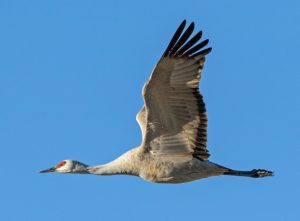The Dance Of The Crane
Annual Migration Through The San Luis Valley
Story and Photos by Reid Neureiter
For the GPHN
 The passenger pigeon is extinct. The plains bison were nearly extirpated. And the great herds of caribou are found hundreds of miles north in Alaska. But we Coloradans still have the opportunity to witness one of the great migrations of the animal kingdom — the biannual migration of thousands of sandhill cranes.
The passenger pigeon is extinct. The plains bison were nearly extirpated. And the great herds of caribou are found hundreds of miles north in Alaska. But we Coloradans still have the opportunity to witness one of the great migrations of the animal kingdom — the biannual migration of thousands of sandhill cranes.
Every year, the cranes migrate through the San Luis Valley in southwest Colorado, as they stop for rest and nourishment while moving between their wintering grounds at the Bosque del Apache National Wildlife Refuge in New Mexico and breeding grounds much further north in Minnesota, Wisconsin, Canada and Alaska.
 Smokey grey birds with white cheeks and bright red caps, sandhill cranes can stand four feet tall with a wingspan of six feet. The largest congregation of migrating sandhill cranes (estimated at 600,000 birds) is found in Nebraska along the banks of Platte River in the sandhill region which gives these majestic creatures their name. But, according to the U.S. Fish and Wildlife Service, an estimated 25,000 to 27,000 cranes stop in the San Luis Valley for the month of March.
Smokey grey birds with white cheeks and bright red caps, sandhill cranes can stand four feet tall with a wingspan of six feet. The largest congregation of migrating sandhill cranes (estimated at 600,000 birds) is found in Nebraska along the banks of Platte River in the sandhill region which gives these majestic creatures their name. But, according to the U.S. Fish and Wildlife Service, an estimated 25,000 to 27,000 cranes stop in the San Luis Valley for the month of March.
The cranes follow a predictable daily pattern: feeding on grain in the agricultural fields through mid-morning, and again in late afternoon and early evening, and retiring to the wetland marshes to roost at night. In mid-day, after their morning feed, the birds fly en masse to so-called “loafing” areas, where they engage in courtship dancing behaviors, such as bowing, wing-spreading, curtseying, jump-turning, and hopping. Once they find their mate, the cranes are bonded for life.
 For the spring migration, the cranes usually begin arriving in mid-February and leave by early April. The best place to see the Colorado cranes is the Monte Vista National Wildlife Refuge, feeding in grain fields in the early morning and again before sunset. Seeing cranes flying up close is most impressive, as they circle and glide low to the ground, dropping their legs and feet almost as an airplane deploys its landing gear, before using their large wings to cushion the final touch down.
For the spring migration, the cranes usually begin arriving in mid-February and leave by early April. The best place to see the Colorado cranes is the Monte Vista National Wildlife Refuge, feeding in grain fields in the early morning and again before sunset. Seeing cranes flying up close is most impressive, as they circle and glide low to the ground, dropping their legs and feet almost as an airplane deploys its landing gear, before using their large wings to cushion the final touch down.
The landscape of the San Luis Valley makes for an inspiring place to watch this migration, with the flocks of stately cranes framed by the snow-capped 14,000 foot peaks of the Sangre de Cristo mountains some 40 miles distant on the eastern Valley edge.
The cranes have been visiting the San Luis Valley for thousands of years and their arrival has been celebrated as long as humans have lived in the Valley. The early Spanish Explorers named the mountains just to the west of Monte Vista the “Sierra de Las Grullas” or “Mountain of the Cranes.” Monte Vista holds an annual Crane Festival, which was cancelled in 2020 due to the pandemic and was held virtually this year on March 12, again because of pandemic fears. But no one told the cranes the live festival was being cancelled, and they appeared as usual by the thousands, blaring their unique loud rattling bugle calls that can be heard up to two miles away.
If you are not able to visit the cranes in the San Luis Valley this spring, do not give up hope. They will be back in the fall. The cranes will return from the north in early September and depart south toward New Mexico by early November. In the meantime, Park Hillians can head to the Denver Museum of Nature and Science in nearby City Park and check out the sandhill crane exhibit on permanent display.





